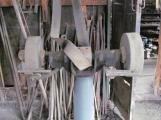1
Selection of hammers
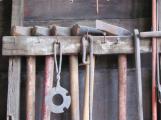
2
Along with the anvil, the hammer is the signature tool in trade of the blacksmth These are but a portion of the hammers in the shop.Depending on the job, various weights and styles of hammers were used. The most popular was a 2 pound cross peen, but everything up to a 10 pound sledge hammer would be used.
3
Various tongs
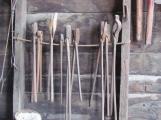
4
While they were a sturdy lot, blacksmiths were almost universal in thinking it was far easier to remove a heated piece from the forge and hold it steady to work on using tongs as opposed to bare hands.As with hammers, a wide variety of tongs were used for different tasks, even more so than hammers. Quite often, a smith would custom make a pair off tongs just for a specific task.
5
Selected tongs
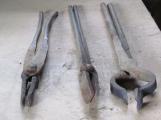
6
This closeup shows three different tongs. The pair on the left of the picture were a general use tool suitable for smaller projects, With them, one is able to grasp either flat work or round stock. The center pair with the longer handles is for holding larger pieces of flat work. The tongs on the right of the picture were purpose made for holding a large round piece.
7
Chisels
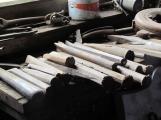
8
Here is a colleciton of chisels. they were used for cutting or piercing metal.
9
Specialized tools were developed over time to make the job easier and more productive. Mr.Ambroz had several such pieces of equipment.
10
Trip hammer

11
The trip hammer was used for large difficult pieces such as plowshares. It stands an easy distance from the forge where the work would be heated and then brought over and placed in the "mouth" of the machine.Foot pressure on the control bar (the semi circular metal piece at floor level) would activate or trip the hammer.It struck the piece with far greater force than possible for a human to deliver. As long as the foot pedal was activated, the hammer would make repeated blows.
12
Trip Hammer,side view
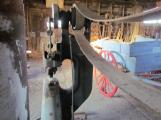
13
Alternate view of trip hammer showing how it connected to the drive belt
14
Grinder
